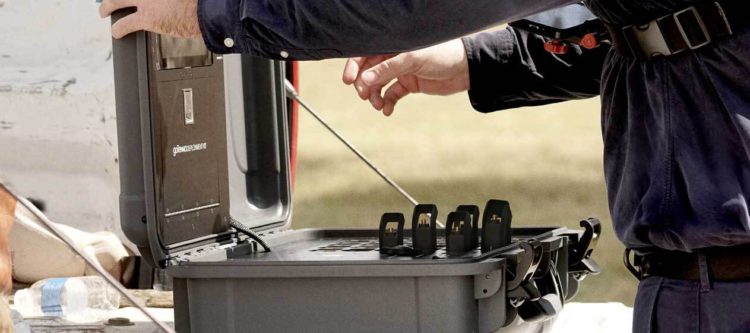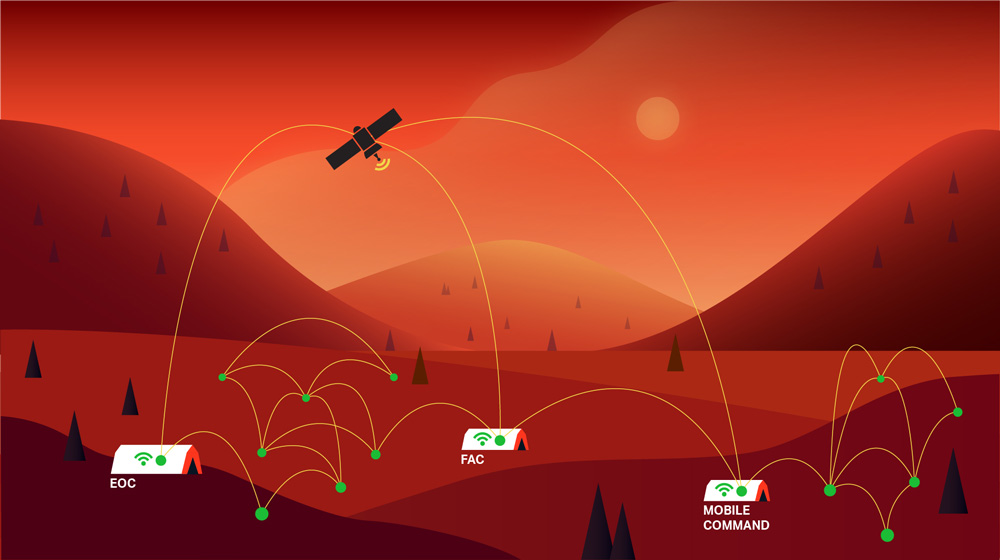Evolving mesh networks hold the key to government IoT initiatives

Digital transformation and modernization initiatives are pervasive across all levels and sectors of our government – from federal civilian agencies, to military organizations, to state and local law enforcement and public safety organizations. Every agency and organization is exploring how new technologies can be implemented within the enterprise to increase efficiency, improve processes, and make operations better and more streamlined.
The end result is anticipated to be a government that operates better, serves constituents more quickly and effectively, and functions even when staffing and resources are constrained.
However, digital transformation comes with some prerequisites. New, connected technologies, applications, and devices can only function if they have the ability to access and transmit data. This means that connectivity is essential for the government of the future – and much of the government operates in places where traditional, terrestrial networks are simply nonexistent.
To overcome this connectivity gap, some government agencies are turning to satellite communications. But others that see the price tag of satellite services as too steep for their requirements are looking to another tool to connect their agents and devices at the tactical edge – mobile mesh networking.
To learn about the technological advancements in mobile mesh networking that are making it a viable tool for connecting governments at the last mile, we recently sat down with Ram Ramanathan, the Chief Scientist at goTenna. Ram’s work has been featured in Scientific American Magazine and an IEEE Journal, just to name a few.
During our discussion, we explored how mobile mesh can power next generation government IoT initiatives, the capabilities that mobile mesh can enable outside of communications and situational awareness, and the exciting new solutions being developed at goTenna.
Here is what Ram told us:
 The Last Mile (TLM): The Last Mile has covered and discussed many of the traditional communications and situational awareness applications and use cases for mobile mesh networks for the military and government. But what other use cases are there for the technology? How could it help with other digital transformation and modernization initiatives across the government?
The Last Mile (TLM): The Last Mile has covered and discussed many of the traditional communications and situational awareness applications and use cases for mobile mesh networks for the military and government. But what other use cases are there for the technology? How could it help with other digital transformation and modernization initiatives across the government?
Ram Ramanathan: There are additional use cases and applications for the current markets that we serve right now – including defense and public safety – and then there are other markets within the government that I think we can serve, as well.
As you’ve said, we are already enabling situational awareness and communications in public safety, defense, and law enforcement. But there are applications beyond those two capabilities that could be interesting for those organizations – such as sharing images. For example, a firefighter may want to take a picture of a fire and then transmit it back to an operations center to give them an idea of what firefighters are facing on the ground.

The challenge that images create for the government is that they require more bandwidth, and often more cost, to transmit. But goTenna is working on solutions that can send images with low bandwidth using innovative protocols.
Then, there’s the opportunity that’s created whenever any government organization -military, law enforcement, public safety or otherwise – needs to enable decentralized operations without infrastructure. This can include robotics networks and drones, to sensors that gauge the water levels of rivers. Mobile mesh networks can give them the opportunity to meet those requirements with no additional operating costs.
There is also a significant need for Low Power, Wide Area IoT Networks, referred to as LPWAN , that are capable of connecting the kinds of IoT solutions and sensors that require long range and are deployed at the last mile. This can include solutions for connecting battlefield and fire-monitoring sensors, smart agriculture, sensors that enable smart cities and smart utilities, and even wildlife monitoring. When you think about those use cases and applications, then you see that there could be a requirement for mobile mesh networking to increase the range and power-efficiency of such networks across all of the government – including federal civilian agencies.
TLM: Are there any specific technical hurdles to overcome or advancements that are necessary to make mobile mesh useful for things like IoT initiatives?
Ram Ramanathan: The main challenge of LPWAN and mobile mesh networking for IoT use cases is making the mesh networking happen even with very low capacity or very low bandwidth. This is a problem that we’ve solved at goTenna to a large extent with a radically new approach called zero control packet forwarding.
To put it in very simple terms, other protocols rely on control packets that go around the network figuring out what the connectivity of the network is and overwhelming the network at the same time. We have managed to get rid of them and use just the data packets as auxiliary control. Because of that we can scale much better because a majority of the bandwidth that is available isn’t being monopolized by control packets.
In addition to increasing scalability, this protocol also increases battery life by decreasing power usage.
TLM: Why would things like power usage be important in these use cases? How can advancements in mobile mesh networking help increase battery life, and what impact could this have on the feasibility of using mobile mesh for advanced government use cases?
Ram Ramanathan: The outdoor operation of wireless devices – especially in remote areas – makes power usage [and] efficiency of paramount importance.
Whether there are agents carrying the devices into the field, or the devices will be connected to sensors that are going to be placed out in the field, the end user wants the longest battery life possible so that they don’t have to keep charging or changing out devices. They want these sensors and the devices that connect them to last months if not years.
What does the power usage depend upon? It depends mostly on the amount of transmissions that are sent. So, we’ve been working to identify intelligent ways to cut down on the number of transmissions, yet make packets go wherever they need to.
One of our protocols called ECHO – which is a part of the Aspen Grove suite – uses an intelligent node-selection algorithm that has managed to cut down the number of transmissions by a factor of three to a factor of five. That would be an incredible power savings in any use case, but IoT use cases for mobile mesh provide even more opportunities.
Many IoT sensors and devices have to transmit long distances. When you utilize mobile mesh for this, you traverse those long distances with multi-hop – relaying from node to node. The average reader might think that the multi-hop nature of mesh networking will increase transmissions and therefore decrease battery life. However, counterintuitively, because the range for each hop is shorter, it more than makes up for the additional energy usage from the extra transmissions. That’s because of a property of wireless transmissions — the longer the range of the transmissions, the disproportionately more power that is needed.
IoT sensors are designed to last for months. But we can extend that even longer with mesh networking both by cutting down on transmissions, and by using multiple short-range hops. This increases the power efficiency of the overall system.
The animation shows the Aspen Grove ECHO protocol in operation. A distributed algorithm adaptively selects a small set of relayers for disseminating broadcast messages like Position Location Information (PLIs). Compared to traditional protocols that have every node relay, ECHO cuts down dramatically on transmissions, increasing scalability and battery life.
TLM: What about scalability? It would seem feasible that meeting the connectivity requirements of large government IoT programs or troop deployments would involve a massive ecosystem of mobile mesh networking nodes. How many nodes can function together in a small area? How large of an area can a mobile mesh network encapsulate? Does the number of concentration of nodes impact a mobile mesh network in any way?
Ram Ramanathan: There are so many dimensions to this problem. Ultimately, scalability depends on four main things:
- The bitrate of the radio
- The traffic load on the network
- The connectivity of the network between the nodes
- The mesh networking protocol
What we have done with Aspen Grove is remove the last one from the picture. Many of the existing mesh network protocols limit scalability just in the way they operate because they have to exchange scout or control packets. These packets monopolize the network and – even with low traffic load – result in limited scalability.
Aspen Grove is a zero control packet protocol. Which means that scalability is only limited by the other three factors. Today, we can connect approximately 30 to 50 nodes. However, if the traffic load is lower, that number can go higher.
TLM: What are some of the exciting new advancements coming out of goTenna today and in the near future that should be exciting for government users? Why would these new technologies or advancements benefit the government?
Ram Ramanathan: We’re currently working on a new version of Aspen Grove with a new Medium-Access Control (MAC) protocol called Slot PINning (SPIN) that can substantially increase performance and the number of hops. This can enable networks to cover a much larger and much more sparse area, which could be essential for use cases like border security, wildland firefighting and disaster relief and response.
We’re also developing a new transport layer protocol that uses some innovative features to enable the sharing of images and other large messages. This will rapidly accelerate the transmission of images from node-to-node, while also enabling the sharing of higher quality images. There are almost unlimited use cases for image sharing in the government, from ISR use cases in the military to information sharing in law enforcement.
We are also looking into making Aspen Grove hardware-agnostic, that is, a software-only solution. We’re working to take the software part of the goTenna device and decouple it from the hardware. This would enable users to run the protocol on other hardware.
Finally we’re exploring a new protocol that we call LIMA (LPWAN IoT Mesh Augmentation) that’s an extension of Aspen Grove to the IoT setting. This new protocol could increase the throughput of an LPWAN IoT system substantially.







No Comment